ECU OLDSMOBILE BRAVADA 1994 Owners Manual
[x] Cancel search | Manufacturer: OLDSMOBILE, Model Year: 1994, Model line: BRAVADA, Model: OLDSMOBILE BRAVADA 1994Pages: 248, PDF Size: 14.54 MB
Page 10 of 248
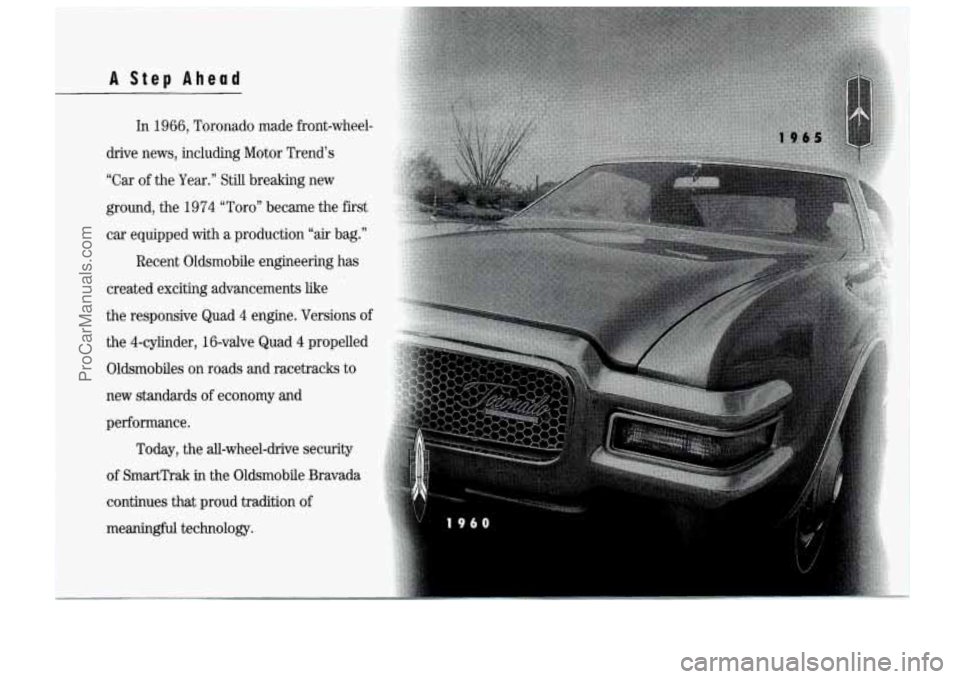
A Step Ahead
In 1966, Toronado made front-wheel-
drive news, including Motor TrendŌĆÖs
ŌĆ£Car
of the Year.ŌĆØ Still breaking new
ground, the 1974 ŌĆ£ToroŌĆØ became the first
car equipped with a production ŌĆ£air bag.ŌĆØ
Recent Oldsmobile engineering has
created exciting advancements like
the responsive Quad 4 engine. Versions
of
the $-cylinder, 16-valve Quad 4 propelled
Oldsmobiles on roads and racetracks to
new standards
of economy and
performance. Today, the all-wheel-drive security
of SmartTrak in the Oldsmobile Bravada
continues that proud tradition
of
meaningful technology.
ProCarManuals.com
Page 11 of 248
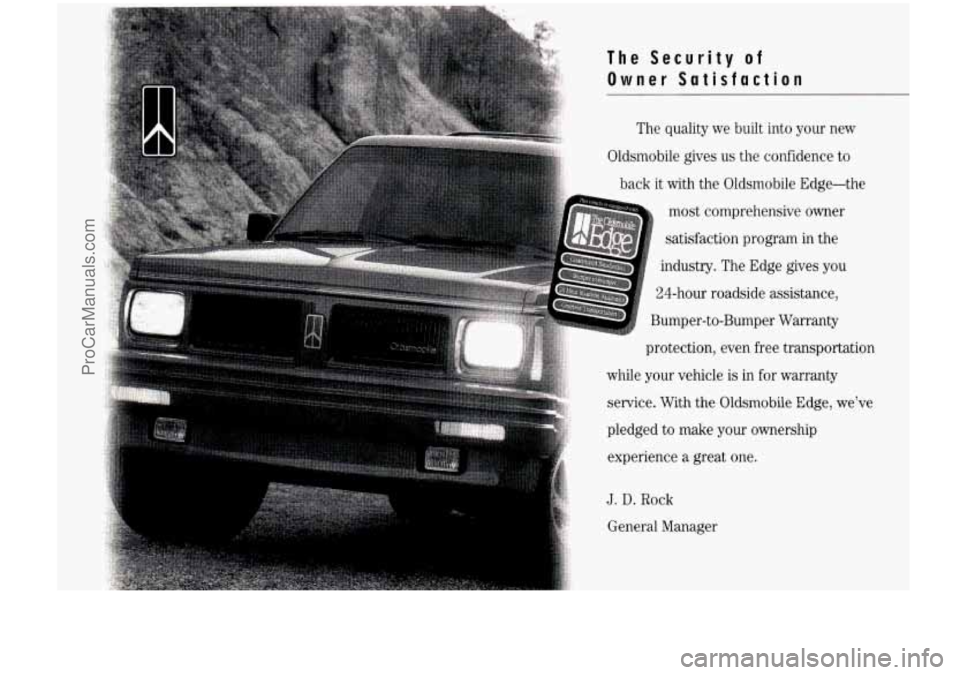
The Security of
Owner Satisfaction
The quality we built into your new
Oldsmobile gives
us the confidence to
back it with the Oldsmobile Edge-the
most comprehensive owner
satisfaction program in the
industry. The Edge gives you
24-hour roadside assistance,
' Bumper-to-Bumper Warranty
protection, even free transportation
while your vehicle is in
for warranty
service. With the Oldsmobile Edge,
we've
pledged to make your ownership
experience a great one.
J. D. Rock
General Manager
ProCarManuals.com
Page 25 of 248

..
3. Pick up the latch plate and pull the
belt across you. DonŌĆÖt let it get
twisted.
4. Push the latch plate into the buckle
until it clicks.
Pull up on the latch plate to make
sure it is secure.
If the belt isnŌĆÖt long enough, see
Safety Belt Extender at the end of
this section.
Make sure the release button
on the
buckle is positioned
so you would be
able to unbuckle the safety belt
quickly if you ever had to. The lap
part of the belt should be worn
low and snug on the hips, just touching
the thighs.
In a crash, this applies force
to the strong pelvic bones. And youŌĆÖd b
less likely to slide under the lap belt. If
you slid under it, the belt would apply
force at your abdomen. This could
cause serious or even fatal injuries. The
shoulder belt should
go over the
shoulder and across the chest. These
parts of the body are best able to take
belt restraining forces.
The safety belt loclts if thereŌĆÖs a sudden
stop or a crash.
Q: WhatŌĆÖs wrong with this?
A: The shoulder belt is too loose. It
wonŌĆÖt give nearly as much protection
this way.
ProCarManuals.com
Page 28 of 248

Seats & Restraint Systems
22
Rear Seat Passengers
ItŌĆÖs very important for rear seat
passengers to buckle up! Accident
statistics show that unbelted people in
the rear seat are hurt more often in
crashes than those who are wearing
safety belts.
Rear passengers who arenŌĆÖt safety
belted can be thrown out
of the vehicle
in a crash. And they can strike others in
the vehicle who are wearing safety belts.
- ~
Rear Seat Outside Passenger
Positions
Lap-Shoulder Belt
The positions next to the windows have
lap-shoulder belts. HereŌĆÖs
how to wear one properly.
1. Pick up the latch plate and pull the
belt across you. DonŌĆÖt let
it get
twisted.
2. Push the latch plate into the buckle
until it clicks. Pull up on the latch
plate to make sure it is secure.
When the shoulder belt is pulled out all
the way, it will lock. If it does, let it go
back all the way and start again.
If the belt is not long enough, see
Safety
Belt Extender at the end of this section.
Make sure the release button
on the
buckle is positioned
so you would be
able to unbuckle the safety belt quickly
if you ever had to.
ProCarManuals.com
Page 32 of 248
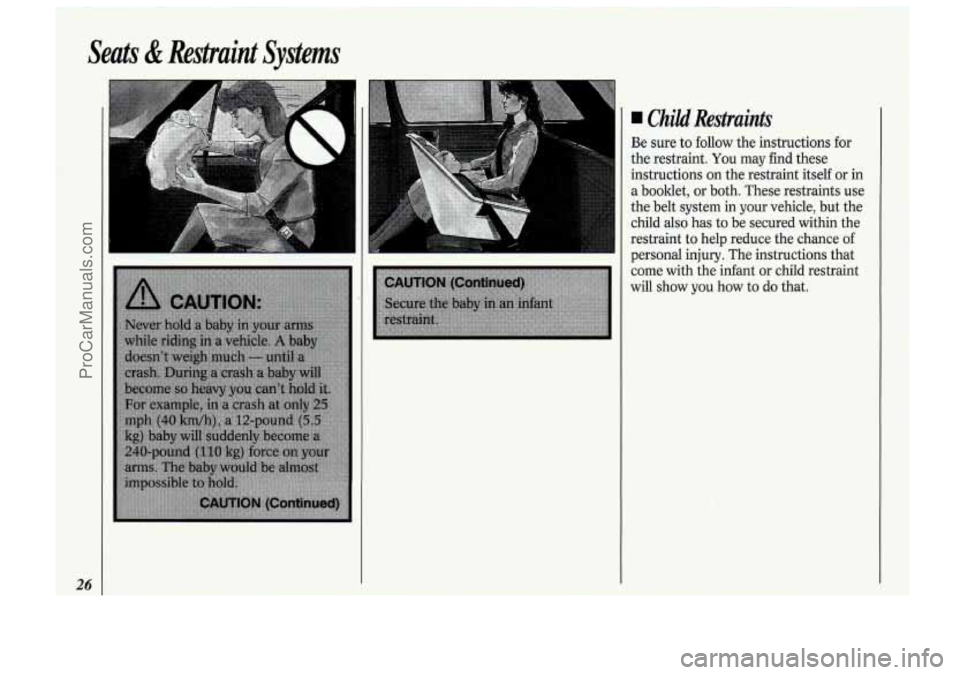
Seats & Restraint Systems
I Child Restraints
Be sure to follow the instructions for
+he restraint. You may find these
atructions on the restraint itself or in
I a booklet, or both. These restraints use
he belt system in your vehicle, but the
hild
also has to be secured within the
estraint to help reduce the chance of
personal injury. The instructions that
come with the infant or child restraint
will show you how to do that.
ProCarManuals.com
Page 33 of 248
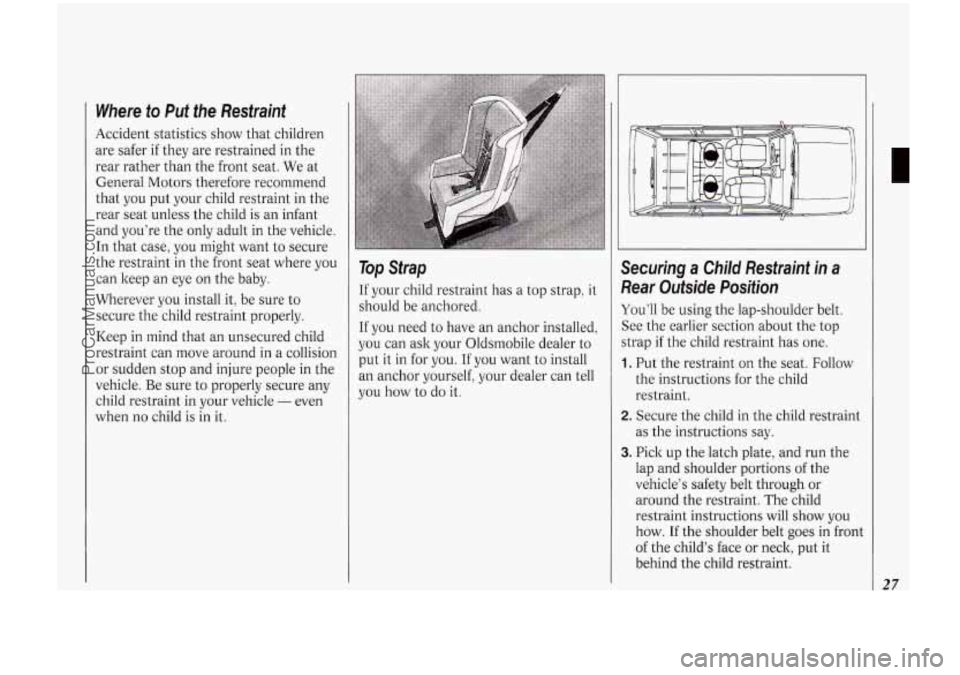
Where to Put the Restraint
Accident statistics show that children
are safer
if they are restrained in the
rear rather than the front seat. We at
General Motors therefore recommend
that you put your child restraint in the
rear seat unless the child is an infant
and youŌĆÖre the only adult in the vehicle.
l In that case, you might want to secure
the restraint in the front seat where
you
can keep an eye on the baby.
Wherever you install it, be sure to
secure the child restraint properly.
ŌĆÖ Keep in mind that an unsecured child
restraint can move around
in a collision
or sudden stop and injure people in the
~ vehicle. Be sure to properly secure any
ŌĆÖ child restraint in your vehicle - even
~
when no child is in it.
fop Strap
If your child restraint has a top strap, it
should be anchored.
If you need to have an anchor installed,
you can ask your Oldsmobile dealer to
put it in for
you. If you want to install
an anchor yourself, your dealer can tell
you how to do
it.
Securing a Child Restraint in a
Rear Outside Position
YouŌĆÖll be using the lap-shoulder belt.
See the earlier section about the top
strap
if the child restraint has one.
1. Put the restraint on the seat. Follow
the instructions for the child
restraint.
as the instructions say.
2. Secure the child in the child restraint
3. Pick up the latch plate, and run the
lap and shoulder portions of the
vehicleŌĆÖs safety belt through or
around the restraint. The child
restraint instructions
will show you
how. If the shoulder belt goes in front
of the childŌĆÖs face or neck, put it
behind the child restraint.
27
ProCarManuals.com
Page 35 of 248

7. Push and pull the child restraint in
different directions to be sure it is
secure.
To remove the child restraint, just
unbuckle the vehicleŌĆÖs safety belt and
let it go back all the way. The safety belt
will move freely again and be ready to
work for an adult or larger child
passenger.
Securing a Child Restraint in a
Center Seat Position
When you secure a child restraint in a
center seating position, youŌĆÖll be using
the lap belt. But donŌĆÖt use the rear
center seat, unless the base of the child
restraint is small enough to let you
reach the buclde and latch plate easily.
See the earlier section about the top
strap
if the child restraint has one.
-
1
2
3
. Male the belt as long as possible by
tilting the latch plate and pulling it
along the belt.
. Put the restraint on the seat. Follow
the instructions for the child
restraint.
as the instructions say.
1. Secure the child in the child restraint
29
ProCarManuals.com
Page 36 of 248
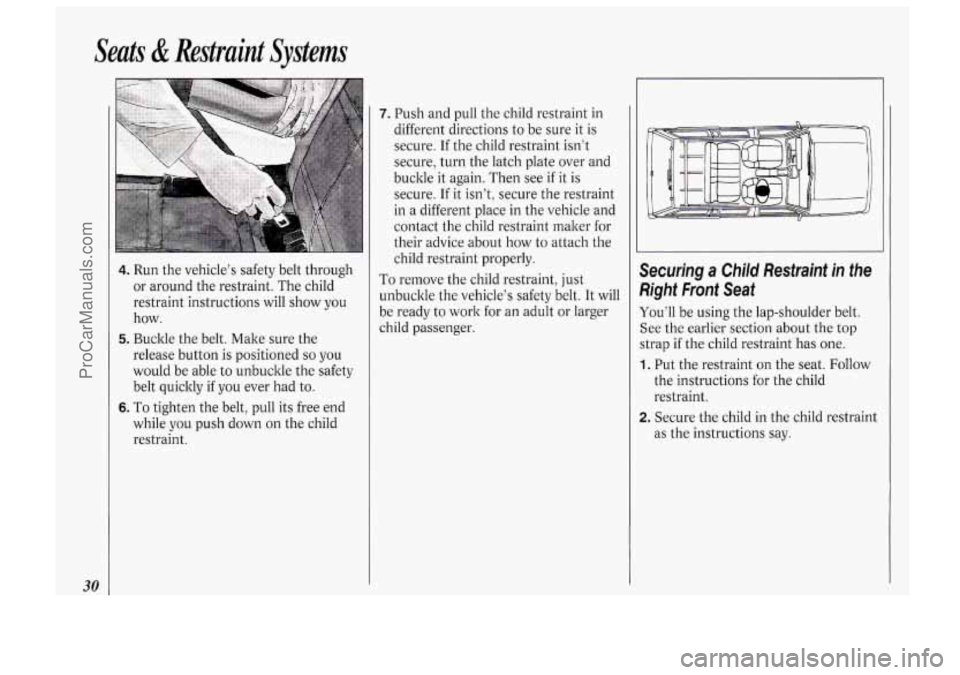
Seats & Restraint Systems
30
4. Run the vehicleŌĆÖs safety belt through
or around the restraint. The child
restraint instructions will show you
how.
release button is positioned
so you
would be able to unbuckle the safety
belt quickly if you ever had to.
6. To tighten the belt, pull its free end
while you push down on the child
restraint.
5. Buckle the belt. Make sure the
7. Push and pull the child restraint in
different directions to be sure it is
secure.
If the child restraint isnŌĆÖt
secure, turn the latch plate over and
buckle it again. Then see
if it is
secure. If it isnŌĆÖt, secure the restraint
in a different place in the vehicle and
contact the child restraint maker for
their advice about
how to attach the
child restraint properly.
To remove the child restraint, just
unbuckle the vehicleŌĆÖs safety belt. It will
be ready to work for an adult or larger
child passenger. Securing a Child Restraint in the
?ight Front Seat
touŌĆśll be using the lap-shoulder belt.
See the earlier section about the top
strap
if the child restraint has one.
1. Put the restraint on the seat. Follow
the instructions for the child
restraint.
as the instructions say.
2. Secure the child in the child restraint
ProCarManuals.com
Page 38 of 248

Seats & Restraint Systems
7. Push and pull the child restraint in
different directions to be sure it
is
secure. Adjust the bucket seat
forward until the lap portion of the
safety belt holds the restraint firmly.
But don't move it any more than
needed to tighten the lap belt.
To remove the child restraint, just
unbuckle the vehicle's safety belt and
let it go back all the way.
The safety belt will move freely again
and be ready to work for an adult or
larger child passenger.
Larger Children
Children who have outgrown child
restraints should wear the vehicle's
safety belts.
If you have the choice, a child should si1
next to a window
so the child can wear
a lap-shoulder belt and get the
additional restraint a shoulder belt can
provide.
Children who aren't buckled up can
Children who aren't buckled up can
be
thrown out in a crash.
strike other people who are.
ProCarManuals.com
Page 50 of 248

Features & Controls
44
HereŌĆÖs How to Move the Arm:
1. Squeeze the release handle to free the
carrier arm.
2. Swing the carrier arm away from the
tailgate. You may need to give it a
slight tug.
To latch the carrier arm, swing it hard
toward the tailgate. The latch has one
catch,
so push hard on the carrier arm
to make sure it has locked in place. If it
is not securely latched, the carrier will
swing freely.
Glove Box
Use the door key to lock and unlock the
glove box. To open, pinch the latch
release.
New Vehicle ŌĆ£BreakmInŌĆØ
NOTICE:
Your modern Oldsmobile doesnŌĆÖt
need an elaborate ŌĆ£break-in.ŌĆØ But it
will perform better in the long run
if you follow these guidelines:
Keep your speed at 55 mph (88
ltm/h) or less for the first 500
miles (804 ltm) .
DonŌĆÖt drive at any one speed -
fast or slow - for the first 500
miles (804 ltm) . DonŌĆÖt make full-
throttle starts.
Avoid malting hard stops for the
first
200 miles (322 lun) or so.
During this time your new brake
linings arenŌĆÖt yet broken in. Hard
stops with new linings can mean
premature wear and earlier
replacement. Follow this
ŌĆ£breaking-inŌĆØ guideline every
time you get new brake linings.
ProCarManuals.com